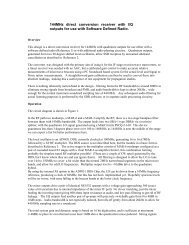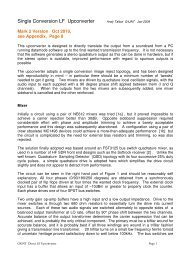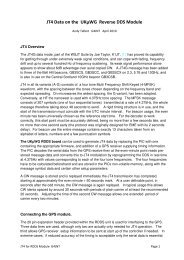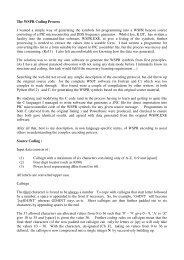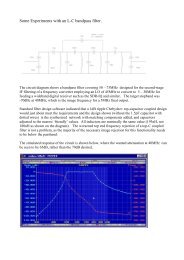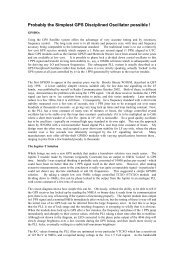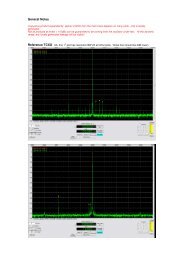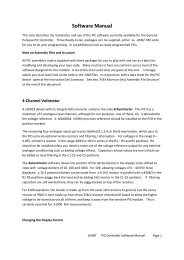Alcatel White Box 24GHz Transceiver experiments and ... - G4JNT
Alcatel White Box 24GHz Transceiver experiments and ... - G4JNT
Alcatel White Box 24GHz Transceiver experiments and ... - G4JNT
- No tags were found...
You also want an ePaper? Increase the reach of your titles
YUMPU automatically turns print PDFs into web optimized ePapers that Google loves.
Results for 1296MHz IFWanted RF 24048MHzImage 21456MHzLO/2 Input 11376MHzSubharmonic test-frequency pairings961.92 / 858.24 (*25)801.6 / 715.2 (*30)668 / 596 (*36)Average of measured unwanted sideb<strong>and</strong> rejection at 1296MHz12dBResults for 800MHz IFWanted RF 24048MHzImage 22448MHzLO/2 Input 11624MHzSubharmonic test-frequency pairings961.92 / 897.92 (*25)801.6 / 748.27 (*30)668 / 623.56 (*36)Average of measured unwanted sideb<strong>and</strong> rejection at 800MHz18dBAdapting the Rx module for a 144MHz IFThe Minicircuits ADQ-180 is a low cost surface mount quadrature combiner covering thefrequency range 120 to 180MHz. It does not have the same pin connections as theoriginal ones used in these modules, but is of a similar size, although slightly thicker.The first job is to remove the old one. With a sharp knife cut the PCB tracks close to theexisting combiner. This is to prevent further damage if the removal process causes themto be lifted – it is essential at all costs that the wire bonds <strong>and</strong> chip components of the<strong>24GHz</strong> hardware are not damaged. These are probably irreparable.It proved impossible to unsolder the original combiner, even with a large soldering iron bit<strong>and</strong> maximum temperature setting. The heat conductivity of the microwave substrate isjust too high. Instead, while applying heat (soldering iron setting 380C, high, large bit)tothe top of the combiner, lever it up with a thin screw driver. Almost certainly the modulewill bend <strong>and</strong> break up. Be vicious <strong>and</strong> use small side cutters to chop away all the bitswhile applying as much heat to the device as you can, but at the same time being verycareful to keep away from the <strong>24GHz</strong> components. Eventually you will manage toremove all the remnants from the PCB, leaving no more than a probably damagedgrounding track underneath the original unit which by now should now be no more than afew tatters of metal <strong>and</strong> white plastic on the floor! Photo 3 shows my removal attempt.
Figure 4 Complete 144MHz IF modificationTest results with 144MHz IFWanted RF 24048MHzImage 23760MHzLO/2 Input 11952MHzSubharmonic test-frequency pairings961.92 / 950.4 (*25)801.6 / 792 (*30)668 / 660 (*36)Average of measured unwanted sideb<strong>and</strong> rejection at 1296MHz12dBAgain, not a brilliant value of sideb<strong>and</strong> rejection, but probably adequate to remove mostof the sideb<strong>and</strong> noise, <strong>and</strong> it does allow the popular 144MHz IF.



